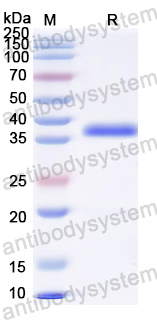Catalog No.
YVV36301
Expression system
E. coli
Species
Human immunodeficiency virus type 1 group M subtype B (isolate HXB2) (HIV-1)
Protein length
Glu2-Glu86
Predicted molecular weight
37.89 kDa
Nature
Recombinant
Endotoxin level
Please contact with the lab for this information.
Purity
>90% as determined by SDS-PAGE.
Accession
P04608
Applications
ELISA, Immunogen, SDS-PAGE, WB, Bioactivity testing in progress
Form
Lyophilized
Storage buffer
Lyophilized from a solution in PBS pH 7.4, 0.02% NLS, 1mM EDTA, 4% Trehalose, 1% Mannitol.
Reconstitution
Reconstitute in sterile water for a stock solution. A copy of datasheet will be provided with the products, please refer to it for details.
Shipping
In general, proteins are provided as lyophilized powder/frozen liquid. They are shipped out with dry ice/blue ice unless customers require otherwise.
Stability and Storage
Use a manual defrost freezer and avoid repeated freeze thaw cycles. Store at 2 to 8°C for frequent use. Store at -20 to -80°C for twelve months from the date of receipt.
Alternative Names
Protein Tat, Transactivating regulatory protein, tat
Autophagy is influenced by vitamin D3 level in people with HIV-1., PMID:40514685
The Potential of Extracellular Vesicle-Mediated Spread of Self-Amplifying RNA and a Way to Mitigate It., PMID:40507927
Macrophage-Derived Factors with the Potential to Contribute to the Pathogenicity of HIV-1 and HIV-2: Roles of M-CSF and CXCL7., PMID:40507836
Retrospective Observational Study of CSF-Derived HIV-1 Tat and Vpr Amino Acid Sequences in a South African Pediatric Cohort with HIV Subtype C., PMID:40507820
High-performance hairpin-whiptail DNA target for HIV-1 integrase assay., PMID:40505931
HIV-1 envelopes from virions that persist in plasma on antiretroviral therapy show reduced susceptibility to autologous immunoglobulins and variable sensitivity to broadly neutralizing monoclonal antibodies., PMID:40502069
Germline-targeting HIV Envelope SOSIP immunization more frequently elicits broadly-neutralizing antibody precursor responses in infant compared to juvenile rhesus macaques., PMID:40501834
The HIV-1 envelope cytoplasmic tail protects infected cells from ADCC by downregulating CD4., PMID:40501789
HIV-1 latency: From acquaintance to confidant., PMID:40497153
HIV-1 Tat mediates microglial NLRP3 inflammasome activation and neurotoxicity by inducing cytosolic mtDNA stress., PMID:40494474
Strong antibody reactivity to HIV-1 synthetic peptides in seropositive indigenous Warao people., PMID:40493828
The macrophage-intrinsic MDA5-IRF5 axis drives HIV-1 intron-containing RNA-induced inflammatory responses., PMID:40493408
Enhancing titers of therapeutic lentiviral vectors using PKC agonists., PMID:40491664
The Different Cellular Entry Routes for Drug Delivery Using Cell Penetrating Peptides., PMID:40490965
Comparative analysis of physicochemical properties and biological activities of chitosans from squid gladius and crab shell., PMID:40490352
Pharmacokinetics Analysis of Serum and Rectal Tissue Concentrations of a Pair of Anti-HIV Monoclonal Antibodies, VRC01 and VRC01LS, in Adults without HIV., PMID:40485091
CD4+ T cell recognition of HIV-1 alternate reading frame proteins., PMID:40475757
The central pore of HIV-1 capsomers promotes sustained stability of the viral capsid., PMID:40475674
Ancient convergence with prokaryote defense and recent adaptations to lentiviruses in primates characterize the ancestral immune factors SAMD9s., PMID:40475432
Development of noninvasive imaging to measure spontaneous pain in mice., PMID:40475419
The conformational epitope of a gp41-specific mucosal protective IgA binds to the HIV-1 envelope and neutralizes infection., PMID:40473821
Neuroinflammation associated with proviral DNA persists in the brain of virally suppressed people with HIV., PMID:40469287
The decameric repeat (DR) of PSGL-1 functions as a basic antiviral unit in restricting HIV-1 infectivity., PMID:40463129
Restriction of HIV-1 infectivity by interferon and IFITM3 is counteracted by Nef., PMID:40463006
Analytical treatment interruption among women with HIV in southern Africa who received VRC01 or placebo in the Antibody Mediated Prevention Study: ATI stakeholder engagement, implementation and early clinical data., PMID:40462491
Antigen persistence and TLR stimulation contribute to induction of a durable HIV-1-specific neutralizing antibody response., PMID:40461490
Targeting HIV-1 immune escape mechanisms: Key advances and challenges in HIV-1 vaccine design., PMID:40460810
Harnessing miRNA dynamics in HIV-1-infected macrophages: Unveiling new targeted therapeutics using systems biology., PMID:40453371
MSBack: Multiscale Backmapping of Highly Coarse-Grained Proteins Using Constrained Diffusion., PMID:40452189
Development of enhanced HIV-1 non-nucleoside reverse transcriptase inhibitors with improved resistance and pharmacokinetic profiles., PMID:40446037
Efficient mRNA delivery to resting T cells to reverse HIV latency., PMID:40442114
Single-cell analyses identify monocyte gene expression profiles that influence HIV-1 reservoir size in acutely treated cohorts., PMID:40442100
Safety, pharmacokinetics, and neutralisation activity of PGDM1400LS, a V2 specific HIV-1 broadly neutralising antibody, infused intravenously or subcutaneously in people without HIV-1 in the USA (HVTN 140/HPTN 101 part A): a first-in-human, phase 1 randomised trial., PMID:40441807
Prevalence and influencing factors of liver injury in naïve patients with HIV/AIDS in Nanjing from 2005 to 2022: Cross-sectional study., PMID:40441186
The road to lenacapavir, a breakthrough HIV treatment., PMID:40440387
Increased immunogen valency improves the maturation of vaccine-elicited HIV-1 VRC01-like antibodies., PMID:40440315
Harnessing flagellin of Ligilactobacillus agilis as a surface display scaffold for an HIV-1 epitope., PMID:40439423
The intestinal interferon system and specialized enterocytes as putative drivers of HIV latency., PMID:40438119
Retrospective analysis of sex-disaggregated immune responses to ALVAC-HIV and bivalent subtype C gp120/MF59 HIV vaccines., PMID:40438096
Discovery of novel diarypyrimidine derivatives as potent HIV-1 NNRTIs by exploiting the tolerant region I within NNRTI binding pocket., PMID:40435828
SAMHD1 enhances HIV-1-induced apoptosis in monocytic cells via the mitochondrial pathway., PMID:40434097
Immunoinformatic-driven design and evaluation of multi-epitope mRNA vaccine targeting HIV-1 gp120., PMID:40433366
Factors Influencing the Binding of HIV-1 Protease Inhibitors: Insights from Machine Learning Models., PMID:40432489
Adaptor Protein Complexes in HIV-1 Pathogenesis: Mechanisms and Therapeutic Potential., PMID:40431726
Genetic Diversity in the Capsid Protein-Coding Region of HIV-1 Circulating in Benguela, Angola: Implications for Primary Resistance to the Novel Capsid Inhibitor Lenacapavir., PMID:40431722
TAR RNA Mimicry of INI1 and Its Influence on Non-Integration Function of HIV-1 Integrase., PMID:40431704
How HIV-1 Uses the Metabolite Inositol Hexakisphosphate to Build Its Capsid., PMID:40431700
A Model of Non-Homologous Recombination Mediated by HIV-1 Reverse Transcriptase Explaining Sequence Motif Duplications That Confer a Replication Fitness Advantage., PMID:40431692
Zinc Supplementation, Inflammation, and Gut Integrity Markers in HIV Infection: A Randomized Placebo-Controlled Trial., PMID:40431411
Involvement of lncRNAs NEAT1 and ZBTB11-AS1 in Active and Persistent HIV-1 Infection in C20 Human Microglial Cell Line., PMID:40429887

